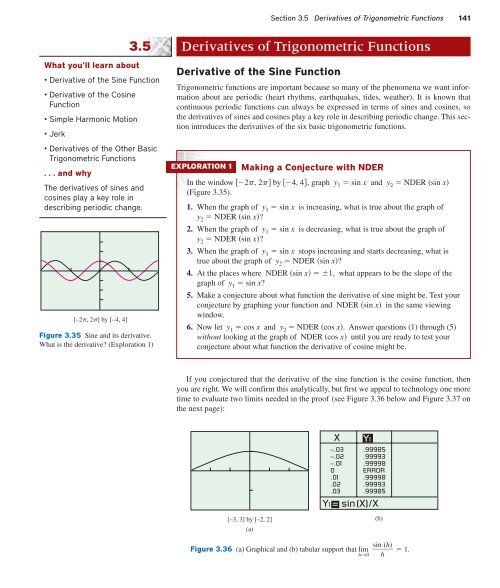5128_Ch03_pp098-184
Create successful ePaper yourself
Turn your PDF publications into a flip-book with our unique Google optimized e-Paper software.
Section 3.5 Derivatives of Trigonometric Functions 141<br />
3.5<br />
What you’ll learn about<br />
• Derivative of the Sine Function<br />
• Derivative of the Cosine<br />
Function<br />
• Simple Harmonic Motion<br />
• Jerk<br />
• Derivatives of the Other Basic<br />
Trigonometric Functions<br />
. . . and why<br />
The derivatives of sines and<br />
cosines play a key role in<br />
describing periodic change.<br />
[–2, 2] by [–4, 4]<br />
Figure 3.35 Sine and its derivative.<br />
What is the derivative? (Exploration 1)<br />
Derivatives of Trigonometric Functions<br />
Derivative of the Sine Function<br />
Trigonometric functions are important because so many of the phenomena we want information<br />
about are periodic (heart rhythms, earthquakes, tides, weather). It is known that<br />
continuous periodic functions can always be expressed in terms of sines and cosines, so<br />
the derivatives of sines and cosines play a key role in describing periodic change. This section<br />
introduces the derivatives of the six basic trigonometric functions.<br />
EXPLORATION 1<br />
Making a Conjecture with NDER<br />
In the window 2p, 2p by 4, 4, graph y 1 sin x and y 2 NDER sin x<br />
(Figure 3.35).<br />
1. When the graph of y 1 sin x is increasing, what is true about the graph of<br />
y 2 NDER sin x?<br />
2. When the graph of y 1 sin x is decreasing, what is true about the graph of<br />
y 2 NDER sin x?<br />
3. When the graph of y 1 sin x stops increasing and starts decreasing, what is<br />
true about the graph of y 2 NDER sin x?<br />
4. At the places where NDER sin x 1, what appears to be the slope of the<br />
graph of y 1 sin x?<br />
5. Make a conjecture about what function the derivative of sine might be. Test your<br />
conjecture by graphing your function and NDER sin x in the same viewing<br />
window.<br />
6. Now let y 1 cos x and y 2 NDER cos x. Answer questions (1) through (5)<br />
without looking at the graph of NDER cos x until you are ready to test your<br />
conjecture about what function the derivative of cosine might be.<br />
If you conjectured that the derivative of the sine function is the cosine function, then<br />
you are right. We will confirm this analytically, but first we appeal to technology one more<br />
time to evaluate two limits needed in the proof (see Figure 3.36 below and Figure 3.37 on<br />
the next page):<br />
X<br />
–.03<br />
–.02<br />
–.01<br />
0<br />
.01<br />
.02<br />
.03<br />
Y1<br />
.99985<br />
.99993<br />
.99998<br />
ERROR<br />
.99998<br />
.99993<br />
.99985<br />
Y1 = sin(X)/X<br />
[–3, 3] by [–2, 2]<br />
(a)<br />
(b)<br />
sin (h)<br />
Figure 3.36 (a) Graphical and (b) tabular support that lim 1.<br />
h→0 h












